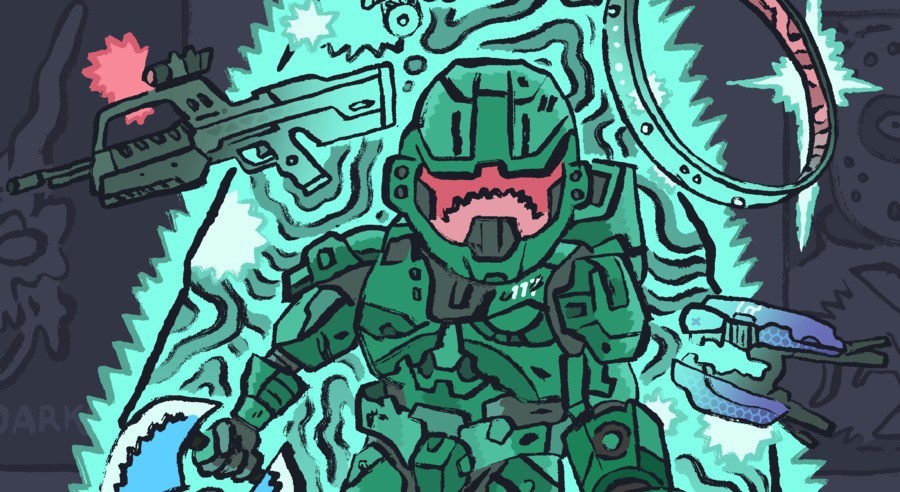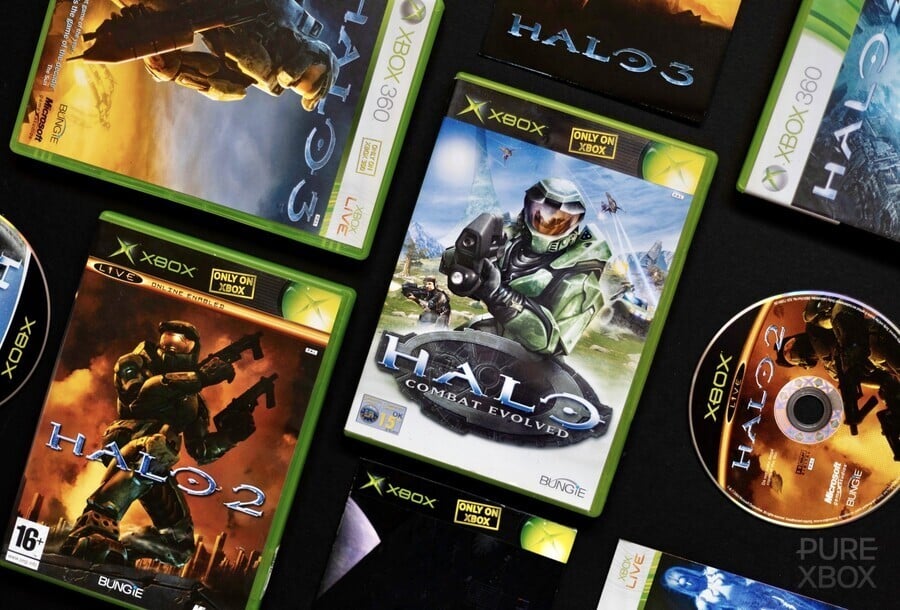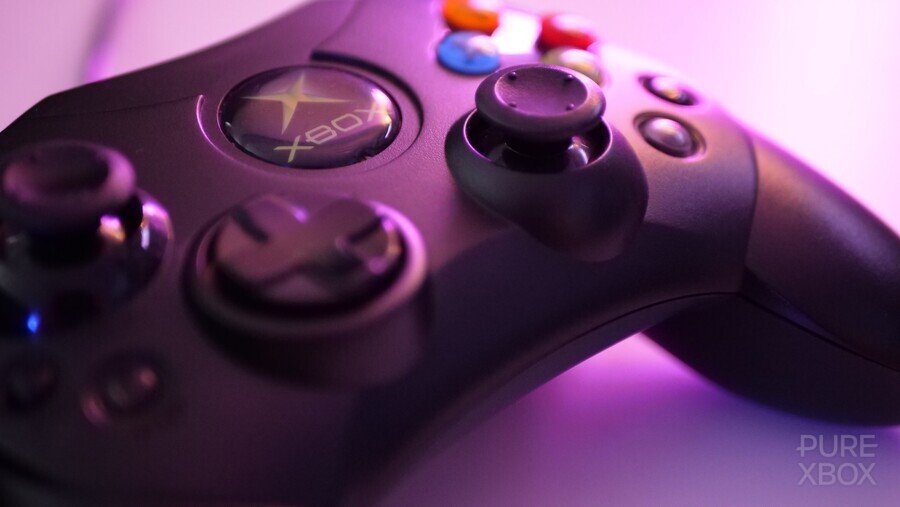
This feature is taken from The Console Chronicles, an upcoming book that we're working on in conjunction with Lost in Cult. If you like what you see, you can pre-order a copy using the link below.
Please note that some external links on this page are affiliate links, which means if you click them and make a purchase we may receive a small percentage of the sale. Please read our FTC Disclosure for more information.
Before the PC juggernaut Microsoft entered the market in 2001, home consoles hadn’t truly succeeded in the world of online multiplayer. In most cases, the only social gaming experiences you had were with your immediate group of friends or family in the same room. And heck, Sony was still only offering a two-player option by default for local play in the early 2000s. While you could claim Sega’s Dreamcast (powered by Microsoft Windows CE) technically did the whole ‘online thing’ first, this concept wasn’t fully realised due to poor system sales. So, it never reached the mainstream masses like Xbox’s original green machine did. Microsoft also played a significant role in popularising LAN play on console as it paved the way for online gaming — drawing from its success on PC with proven hits like Age of Empires.
Here I was, a diehard late '90s Nintendo fan. Unfortunately, the seemingly indestructible Japanese company fell from grace when the GameCube launched. It was even worse from my perspective. I was the only person who owned a GameCube in my entire grade — perhaps the only one in the whole high school. The system sold just 21.74 million units worldwide, so I’m sure I wasn’t the only ‘Nintendo loner’ out there. Most of the kids in my class had already been ingratiated into the PlayStation family with series like Crash Bandicoot and Metal Gear Solid, and I owned the weird-looking purple system that was more comparable to a Fisher-Price toy… or so I was told. I’d fought plenty of lunchtime battles over the years, ruthlessly defending Mario and friends. But by the end of 2001, I was at my breaking point.
Following Xbox’s launch, the arguments with classmates quickly shifted from Sony and Nintendo to the new player on the block along with its oversized hardware, now-famous Duke controller, and Spartan super soldier Master Chief
I remember going down to my local electronics retailer in the years leading up to Nintendo’s sixth generation console release and seeing a dwindling collection of Dreamcast titles as Sega struggled to maintain relevance in the hardware space. It only got worse for the blue hedgehog’s system when Sony’s PlayStation 2 arrived on the scene and became the hottest-selling item, partly because of its handy built-in DVD player. I never ended up getting a Dreamcast during these years — as much as I wanted to play Sonic Adventure and games like Jet Set Radio — and there was no way I was swapping to PS2, even if games like Devil May Cry looked utterly amazing. I was stuck with Nintendo’s cube, and it just didn’t quite deliver the same level of buzz as its predecessor.
Don’t get me wrong, Nintendo’s newest console had an outstanding first-party library. However, it was arguably downhill from there, due to the lack of third-party support and the fact that PlayStation had already won before Nintendo was even on the starting line. In PAL regions, the GameCube actually released after the Xbox as well. While I had committed to another generation of Mario, there was admittedly an instantaneous sense of regret when the hype for this new American gaming console reached fever pitch in the schoolyard.
Following Xbox’s launch, the arguments with classmates quickly shifted from Sony and Nintendo to the new player on the block along with its oversized hardware, now-famous Duke controller, and Spartan super soldier Master Chief. By the holiday season, Xbox had become a massive disruptor thanks to Halo and other platform exclusives. Nintendo had already well and truly lost this generation by then, falling back on the GBA. Although Sony was riding high on its pile of money, it now had a new, resourceful competitor that was showing interest in taking a sizable chunk of its ‘mature’ audience while revolutionising the way console gamers played together.

The small team of masterminds behind the Xbox had the foresight to see that online gaming could develop into a core experience on console. So, these same talented people pushed executives at Microsoft to fund a built-in Ethernet port to future-proof the system for the rollout of broadband. Adding to this was the system’s DirectX origin, which aimed to make creating games for this console easier than ever. Paired with Halo: Combat Evolved, Microsoft immediately ignited phase one of its grander vision, simply revolutionising online console multiplayer.
Gaming with friends quickly transformed from split-screen affairs to the realm of LAN parties. Halo’s first outing was almost exclusively responsible for this and was immediately touted as the Xbox launch game you simply had to own. Linking your system to others and playing with up to 16 Spartans in firefights across a battlefield… It was a blast in every sense of the word.
I can’t count the amount of Halo LAN parties I participated in, each filled with heated moments, hysterical laughter and someone doing a Warthog manoeuvre that nobody thought was possible
Similar scenes played out across the world. Friends would come together over a few days (or entire weeks) to play non-stop. It was these nights of pizza, corn chips and fizzy drinks that ended up making Bungie’s military sci-fi series a household name and one of the greatest video game franchises of all-time. Adding to this was a huge campaign and memorable quotes about Master Chief “just getting started,” which also reinforced the fact Xbox was very much here to stay.
At this point, I couldn’t resist the electric-green glow any longer. My brother and I had a friend who secured an Xbox at launch, and from there, word about this absolute beast of a console (not to mention Master Chief’s mission to save humanity) spread far and wide across town. Hungry for a next-generation multiplayer shooter, we finally pulled the trigger. This was our first time ever owning a rival platform, and it really did give us a newfound appreciation for video games.
I can’t count the amount of Halo LAN parties I participated in, each filled with heated moments, hysterical laughter and someone doing a Warthog manoeuvre that nobody thought was possible. I went from being an isolated gamer to actually having a social life again, thanks to Xbox. On weekends, I would hang out with my mates and play Halo late into the night, and then head to school on Monday ready to do it all over again.

That’s not to say there weren’t other quality games on the Xbox. Microsoft’s new hardware ended up being a gateway to more third-party titles for my younger self. Although I still hadn’t properly experienced a 3D Sonic game at this stage, I was introduced to other modern Sega titles like Jet Set Radio Future and eventually the arcade racing hit OutRun 2.
Xbox also had a selection of quality RPGs, ranging from Star Wars: Knights of the Old Republic to Bethesda’s first Xbox release, Elder Scrolls III: Morrowind. And then there was Lionhead’s Fable. Even if it didn’t live up to everyone’s expectations or fulfil certain promises made by the ever-optimistic Peter Molyneux, it was one game that charmed my socks off with its infectious humour and those groundbreaking ‘good’ and ‘evil’ decisions that could impact your time in Albion. You could even get married and own a house! I still remember one friend describing the gameplay to me before I even knew what Fable was — I was completely sold on the concept alone. And to top it off, you had other series like Project Gotham Racing, Dead or Alive and Blinx. Microsoft bolstered the system’s library further down the line with games like Forza Motorsport and Rare’s debut Xbox title, Grabbed by the Ghoulies.
That famous Ethernet port linked Microsoft’s green army of gamers to the online world, and this was followed by the rollout of the Xbox Live Starter Kit containing a basic headset and subscription to the new online service
However, it wasn’t just Xbox’s variety of games and exclusives in the spotlight. The major breakthrough for the system was the arrival of Xbox Live. That famous Ethernet port linked Microsoft’s green army of gamers to the online world, and this was followed by the rollout of the Xbox Live Starter Kit containing a basic headset and subscription to the new online service. And yes, you had to pay for it — that was even a bit of a controversial decision within the walls of Microsoft. This was a new concept back then, but it was a model that the rest of the industry would eventually replicate.
As envisioned, online gaming was part of Microsoft’s long-term plan for its console business. New users signed up to the ecosystem, created their own online alias in the form of a Gamertag, and were welcomed into this exclusive worldwide club. While the service started off with some decent games like MechAssault, it was Bungie’s seismic follow-up to Combat Evolved, Halo 2, that comprehensively sold the masses on Xbox Live — reinforcing Microsoft’s position as a serious competitor in the console arena.
The combination of Halo 2 and online play was unrivalled. After years of the original game’s multiplayer, the second game took this sci-fi universe higher with a new arsenal, new mechanics, and a rich narrative. The sequel evolved the FPS genre like its predecessor, connecting Halo fans around the globe. It really was a moment in games history like no other, with Xbox’s vision of an online community on full display.

I took drastic measures to play Halo 2 online, befriending someone from my school simply because he had access to Live before everyone else. I'm ashamed to say that I wasn’t actually in it for the friendship. But that’s just how keen I was for a fix, as my family didn’t have access to broadband then. I recall the first time that I went over to his place to play against other Spartans online — it was truly incredible and everything ran great. As my video game magazines of the time told me, Halo was uniting players the world over. This new online multiplayer model for Microsoft was proving to be a huge victory, and this social experience became revolutionary.
Microsoft’s success on the console front snowballed, with Xbox Live becoming its defining feature — thanks in no small part to Halo 2 and Bungie’s blockbuster efforts. It made the Xbox a must-have console. All Nintendo and Sony could really do was watch Xbox’s online service break one subscription milestone after the other and take notes — once again reinforcing how pivotal the Xbox Live era was to the rest of the industry. While it only sold a modest 24 million consoles worldwide, the original Xbox made an outsized impact.
All Nintendo and Sony could really do was watch Xbox’s online service break one subscription milestone after the other and take notes — once again reinforcing how pivotal the Xbox Live era was to the rest of the industry
I rode the Xbox bandwagon from the earlier years of high school until I graduated. While I was still a Nintendo fan during this time, it was Xbox’s networking abilities, Live service and Halo series that provided me some of my most memorable gaming moments because they were shared with others. Halo 2 also announced itself as top dog to the rest of the entertainment industry — breaking records and being classed as the event of a lifetime by some diehard fans. The anticipation was off the charts and the launch ended up making a small fortune for Microsoft. All of this combined to lay the key foundations for modern gaming as we know it — continuing Chief and Cortana’s space adventure while driving the online multiplayer boom. The Xbox and Xbox Live vastly broadened my understanding of video games and the world around me, offering up all sorts of new and unmatched moments. My love of Halo has also stuck over the years, and the series has been a mainstay in my gaming schedule since the launch of Combat Evolved.
Without Microsoft’s original system, home console gaming wouldn’t be the social experience it is today. Xbox became the blueprint. The team behind it had enough knowledge and ambition to see the way the world was going in the new millennium and with Bungie’s help, Microsoft was able to deliver a killer first-party exclusive in the form of Halo 2. It changed the medium forever, pushing online multiplayer into the mainstream and creating the company’s most recognisable IP in the process. Microsoft needed a serious weapon to enter the console market, and it got just that, thanks to the success of Master Chief, the ingenuity of Xbox Live, and a simple Ethernet port.